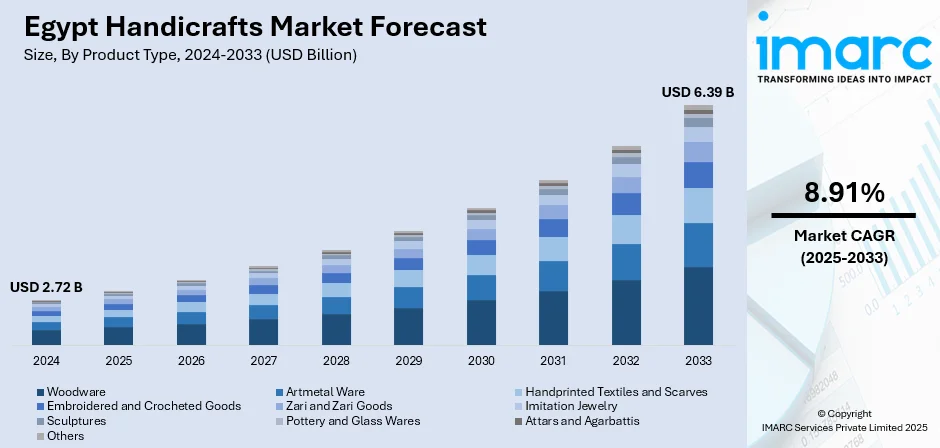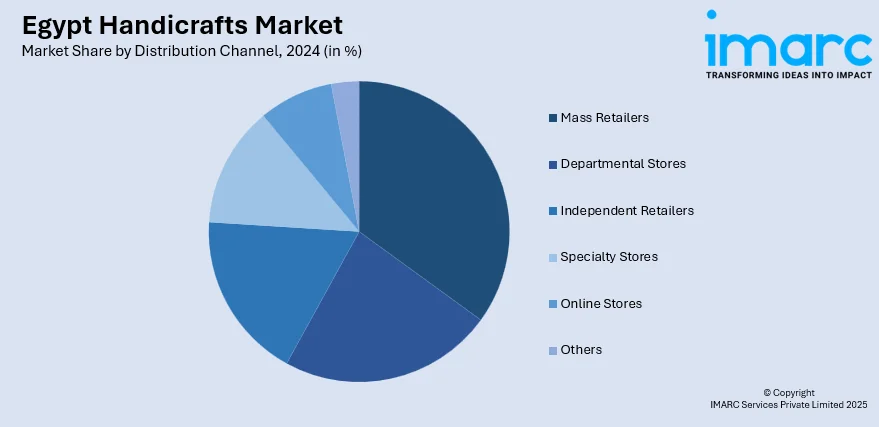
Egypt Handicrafts Market Size, Share, Trends and Forecast by Product Type, Distribution Channel, End Use, and Region, 2025-2033
Egypt Handicrafts Market Overview:
The Egypt handicrafts market size reached USD 2.72 Billion in 2024. Looking forward, the market is projected to reach USD 6.39 Billion by 2033, exhibiting a growth rate (CAGR) of 8.91% during 2025-2033. Growing interest in cultural preservation, increased domestic and foreign travel, and a growing desire for unique, handcrafted goods are the main factors propelling the industry. Additionally, artists can now effortlessly access a worldwide audience due to the growth of online shopping platforms, which has increased the Egypt handicrafts market share.
|
Report Attribute
|
Key Statistics
|
|---|---|
|
Base Year
|
2024
|
|
Forecast Years
|
2025-2033
|
|
Historical Years
|
2019-2024
|
| Market Size in 2024 | USD 2.72 Billion |
| Market Forecast in 2033 | USD 6.39 Billion |
| Market Growth Rate 2025-2033 | 8.91% |
Egypt Handicrafts Market Trends:
Rising Demand from Tourism Industry
Tourism is one of the biggest drivers of the Egypt handicrafts market, as millions of international visitors purchase traditional crafts as souvenirs. As per the Trading Economics, in FY 2023/2024, tourism revenues in Egypt rose to 14.40 USD Billion, up from 13.60 USD Billion in FY 2022/2023. Egypt’s reputation as a global tourist destination ensures consistent exposure for local artisans, with handicrafts being popular in bazaars, cultural festivals, and duty-free shops. Tourists often value handcrafted products as unique keepsakes that represent their travel experience, making pottery, papyrus paintings, jewelry, and textiles highly sought-after. Additionally, tourism supports the growth of small-scale artisan businesses by providing them with access to international buyers who may also export these goods to their home countries.

To get more information on this market, Request Sample
Growth of E-commerce and Digital Channels
E-commerce and digital channels are transforming Egypt’s handicrafts market by connecting artisans directly with people, both locally and internationally. As per the IMARC Group, the Egypt e-commerce market size reached USD 93.7 Million in 2024. Online marketplaces and social media channels allow craftsmen to showcase their products, reach wider audiences, and bypass traditional intermediaries. Younger artisans are leveraging digital platforms to promote unique handmade items to global buyers who seek authentic cultural products. These platforms also enable better storytelling, where artisans can share the heritage behind each item, making their crafts more appealing. Additionally, online payment systems and delivery networks make it easier for both domestic and international customers to purchase handicrafts conveniently.
Rising Global Demand for Sustainable Products
User preferences are increasingly shifting towards sustainable, handmade, and ethically sourced products, which strongly benefits the Egypt handicrafts market. According to the Voice of the Consumer 2024: Regional findings, 56% of surveyed users in Egypt were keen on purchasing more sustainable products to lessen their environmental impact. Many Egyptian crafts are made using natural materials, such as clay, wood, textiles, and recycled components, aligning with sustainable living trends. People in Western markets particularly appreciate the low environmental impact of handmade goods compared to mass-produced alternatives. This sustainability angle is not only increasing the value of Egyptian handicrafts abroad but also positioning them competitively in premium markets. Artisans are creating innovative designs that blend traditional skills with modern eco-friendly practices.
Key Growth Drivers of Egypt Handicrafts Market:
Strong Cultural Heritage and Craftsmanship
The market is strongly driven by Egypt’s rich cultural heritage and centuries-old craftsmanship traditions. Handicrafts, such as pottery, glasswork, carpets, and jewelry, are deeply tied to Egypt’s history and identity, making them highly valued both locally and globally. Artisans continue to pass down skills through generations, ensuring the authenticity and preservation of traditional designs. This cultural foundation is not only providing artisans with a strong competitive advantage but also driving steady demand for products that embody Egyptian heritage. Tourists and collectors often seek out authentic handmade items as symbols of Egypt’s historic legacy. Locally, Egyptians purchase handicrafts for both cultural pride and decorative purposes, which sustains domestic adoption. The strong identity attached to Egyptian handicrafts ensures their resilience and appeal, making heritage and craftsmanship a central factor fueling the growth of the market.
Government Support and Initiatives
The Egyptian government is playing a vital role in driving the market expansion through initiatives aimed at preserving heritage and promoting local artisans. Programs supporting small and medium-sized enterprises (SMEs) in handicrafts provide artisans with financial aid, training, and access to local and international markets. Government-backed exhibitions and craft fairs create platforms for artisans to showcase their products to both tourists and buyers from abroad. Additionally, cultural projects that emphasize heritage preservation ensure that traditional crafts remain relevant in modern markets. Policies promoting exports and support for artisan cooperatives are also strengthening the industry’s structure and visibility. By positioning handicrafts as both an economic sector and a cultural asset, the government is creating opportunities for long-term sustainability.
Employment and Rural Development Opportunities
Handicrafts provide significant employment opportunities in Egypt, particularly in rural areas where traditional skills are preserved and practiced. Many families rely on handicraft production as a primary or supplementary source of income, ensuring that these crafts remain economically and socially important. Women and youth, in particular, benefit from the handicrafts sector, as it allows them to participate in the workforce through home-based or community-centered production. This inclusivity drives rural development while supporting social and economic empowerment. As global and local demand for handmade products is growing, artisans are encouraged to sustain and expand their production. Additionally, cooperative models and training programs are helping artisans improve quality and market access. By fostering rural employment and social inclusion, the handicrafts sector is not only strengthening Egypt’s economy but also preserving cultural identity.
Egypt Handicrafts Market Segmentation:
IMARC Group provides an analysis of the key trends in each segment of the market, along with forecasts at the region/country level for 2025-2033. Our report has categorized the market based on product type, distribution channel, and end use.
Product Type Insights:
- Woodware
- Artmetal Ware
- Handprinted Textiles and Scarves
- Embroidered and Crocheted Goods
- Zari and Zari Goods
- Imitation Jewelry
- Sculptures
- Pottery and Glass Wares
- Attars and Agarbattis
- Others
The report has provided a detailed breakup and analysis of the market based on the product type. This includes woodware, artmetal ware, handprinted textiles and scarves, embroidered and crocheted goods, zari and zari goods, imitation jewelry, sculptures, pottery and glass wares, attars and agarbattis, and others.
Distribution Channel Insights:

- Mass Retailers
- Departmental Stores
- Independent Retailers
- Specialty Stores
- Online Stores
- Others
A detailed breakup and analysis of the market based on the distribution channel have also been provided in the report. This includes mass retailers, departmental stores, independent retailers, specialty stores, online stores, and others.
End Use Insights:
- Residential
- Commercial
The report has provided a detailed breakup and analysis of the market based on the end use. This includes residential and commercial.
Regional Insights:
- Greater Cairo
- Alexandria
- Suez Canal
- Delta
- Others
The report has also provided a comprehensive analysis of all the major regional markets, which include Greater Cairo, Alexandria, Suez Canal, Delta, and others.
Competitive Landscape:
The market research report has also provided a comprehensive analysis of the competitive landscape. Competitive analysis such as market structure, key player positioning, top winning strategies, competitive dashboard, and company evaluation quadrant has been covered in the report. Also, detailed profiles of all major companies have been provided.
Egypt Handicrafts Market News:
- February 2025: The ‘Diarna for Handicrafts and Heritage’ exhibition took place at Cairo Festival City Mall, highlighting more than 400 exhibitors displaying Egypt's abundant handicraft legacy. The exhibition sought to enhance artisans' potential by offering marketing avenues and encouraging cooperation between public and private sectors, involving ALEXBANK, Sawiris Foundation, and Drosos Foundation.
- December 2024: The Prime Minister of Egypt, Dr. Mostafa Madbouly, inaugurated the sixth edition of the ‘Our Heritage 2024’ exhibition featuring products, crafts, and heritage, taking place at the Egypt International Exhibition Center in the Fifth Settlement, running from December 12 to 21. The exhibition served as a vital platform for presenting and promoting unique artistic creations from handicrafts and heritage, in line with presidential directives aimed at revitalizing these crafts and industries.
Egypt Handicrafts Market Report Coverage:
| Report Features | Details |
|---|---|
| Base Year of the Analysis | 2024 |
| Historical Period | 2019-2024 |
| Forecast Period | 2025-2033 |
| Units | Billion USD |
| Scope of the Report |
Exploration of Historical Trends and Market Outlook, Industry Catalysts and Challenges, Segment-Wise Historical and Future Market Assessment:
|
| Product Types Covered | Woodware, Artmetal Ware, Handprinted Textiles and Scarves, Embroidered and Crocheted Goods, Zari and Zari Goods, Imitation Jewelry, Sculptures, Pottery and Glass Wares, Attars and Agarbattis, Others |
| Distribution Channels Covered | Mass Retailers, Departmental Stores, Independent Retailers, Specialty Stores, Online Stores, Others |
| End Uses Covered | Residential, Commercial |
| Regions Covered | Greater Cairo, Alexandria, Suez Canal, Delta, Others |
| Customization Scope | 10% Free Customization |
| Post-Sale Analyst Support | 10-12 Weeks |
| Delivery Format | PDF and Excel through Email (We can also provide the editable version of the report in PPT/Word format on special request) |
Key Benefits for Stakeholders:
- IMARC’s industry report offers a comprehensive quantitative analysis of various market segments, historical and current market trends, market forecasts, and dynamics of the Egypt handicrafts market from 2019-2033.
- The research report provides the latest information on the market drivers, challenges, and opportunities in the Egypt handicrafts market.
- Porter's five forces analysis assist stakeholders in assessing the impact of new entrants, competitive rivalry, supplier power, buyer power, and the threat of substitution. It helps stakeholders to analyze the level of competition within the Egypt handicrafts industry and its attractiveness.
- Competitive landscape allows stakeholders to understand their competitive environment and provides an insight into the current positions of key players in the market.
Key Questions Answered in This Report
The handicrafts market in Egypt was valued at USD 2.72 Billion in 2024.
The Egypt handicrafts market is projected to exhibit a CAGR of 8.91% during 2025-2033, reaching a value of USD 6.39 Billion by 2033.
Tourists value traditional crafts, such as pottery, textiles, and jewelry, while local artisans are expanding exports to international markets. Government initiatives supporting small artisans, craft fairs, and e-commerce platforms are also boosting visibility and sales. The growing preferences for unique, sustainable, and authentic products are further driving the demand for Egyptian handicrafts domestically and abroad.
Need more help?
- Speak to our experienced analysts for insights on the current market scenarios.
- Include additional segments and countries to customize the report as per your requirement.
- Gain an unparalleled competitive advantage in your domain by understanding how to utilize the report and positively impacting your operations and revenue.
- For further assistance, please connect with our analysts.
 Request Customization
Request Customization
 Speak to an Analyst
Speak to an Analyst
 Request Brochure
Request Brochure
 Inquire Before Buying
Inquire Before Buying




.webp)




.webp)












